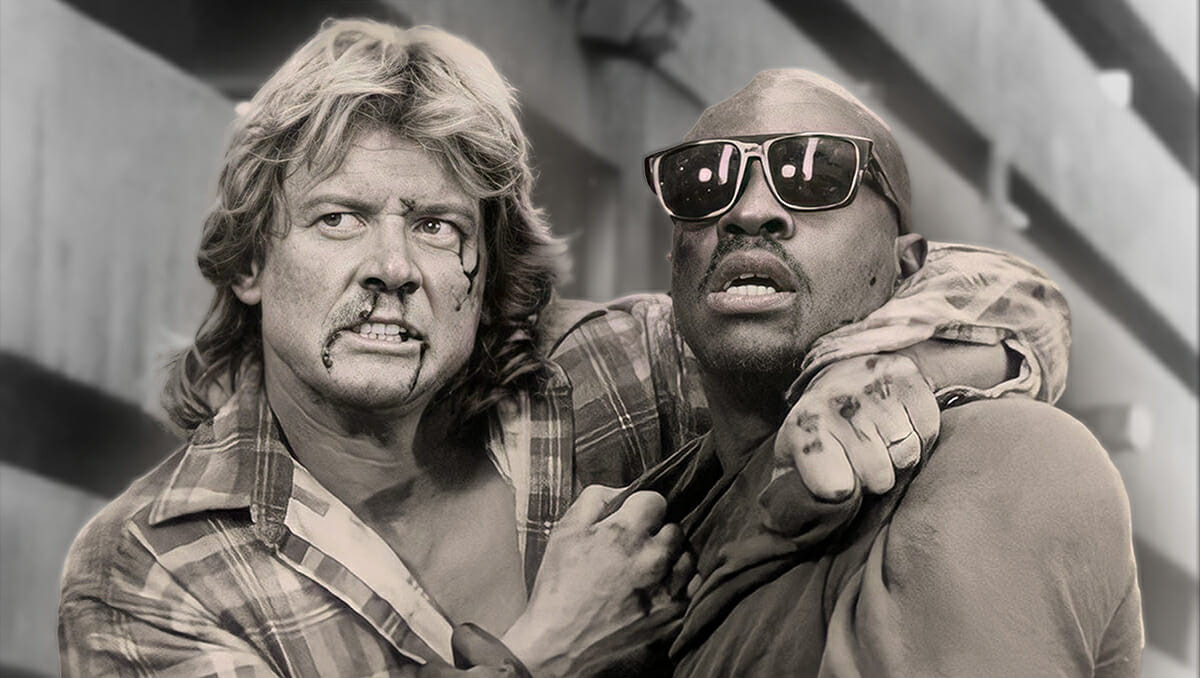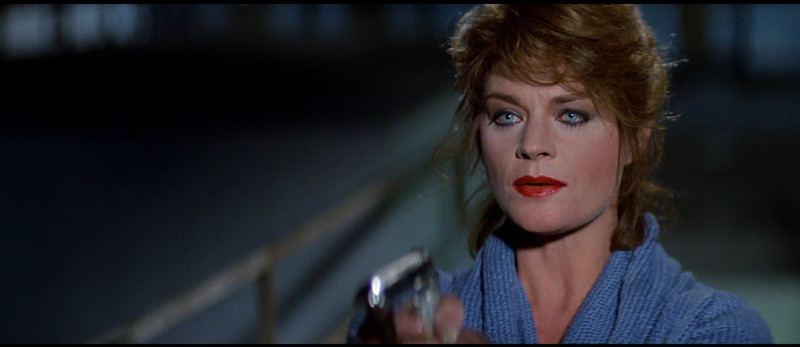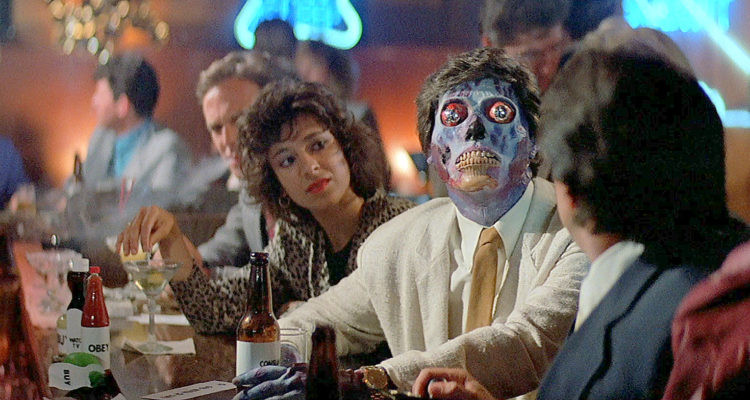John Carpenter’s 1988 film, They Live, has permeated popular culture through memes and references for years. Finally experiencing it, it’s clear why this movie has cemented its status as a cult classic, even if it’s not always listed among Carpenter’s top-tier works. Starring Roddy Piper, Keith David, and Meg Foster, They Live delivers a potent message about societal control wrapped in a science fiction B-movie package. While the plot may have its loose ends and the acting can be uneven, particularly Foster’s surprisingly flat performance, the film’s core themes resonate deeply, making it a compelling watch even today.
The strength of the performances lies with Keith David as Frank, who brings a grounded realism to his role, and Peter Jason as Gilbert, the pragmatic leader of the homeless encampment. George “Buck” Flower also adds a memorable touch as the enigmatic Drifter. The narrative centers around Nada, played by wrestler Roddy Piper (the character remains unnamed), a construction worker who arrives in a struggling Los Angeles seeking work. He encounters a compelling Street Preacher (Raymond St. Jacques), whose sermons deviate from traditional religious dogma, focusing instead on a more earthly warning: “they” are stealing our freedom and enslaving humanity.
 Scene from the 1988 film “They Live”
Scene from the 1988 film “They Live”
Securing a construction job, Nada meets Frank, a man who left his family in Detroit due to the lack of employment opportunities. Both men are economic migrants, victims of a system that offers few prospects. While Nada maintains a degree of optimism, Frank paints a stark picture of a dog-eat-dog world, where even those in similar precarious positions are pitted against each other in a struggle for survival. This sets the stage for the film’s exploration of societal manipulation and control, key themes that solidify They Live as more than just a typical sci-fi flick.
Frank leads Nada to a homeless camp managed by Gilbert, located across from a church. Initially, the community appears welcoming, but Nada soon observes secretive activities centered around Gilbert and the Preacher within the church. Intriguingly, some residents are glued to a cable TV channel, its broadcasts intermittently overridden by a video pirate echoing the Preacher’s warnings. This early setup cleverly hints at a deeper conspiracy at play, drawing the audience into Nada’s unfolding discovery.
Driven by curiosity, Nada sneaks into the church and uncovers a hidden resistance movement led by Gilbert and the Preacher. He finds a makeshift laboratory and, bizarrely, stacks upon stacks of sunglasses. This discovery is abruptly interrupted by a brutal raid. Riot police descend upon the camp with helicopters and bulldozers, violently evicting the residents. The resistance members manage to escape with their mysterious boxes, leaving behind a leveled camp and a severely beaten Preacher. This aggressive police action serves as a stark visual metaphor for the oppressive forces at work in They Live.
In the aftermath, Nada returns to the ravaged camp, hoping to salvage anything. Amidst the debris, he finds a box of sunglasses that escaped the police sweep and hides it in a nearby alley. Donning a pair, Nada’s world is irrevocably altered. The film transitions to a stark monochromatic palette, revealing the insidious truth: every advertisement, magazine, and TV screen is embedded with subliminal commands – “Obey,” “Consume,” “Conform.” Even money itself is branded, “This is your God.”
 Roddy Piper in the 1988 film “They Live”
Roddy Piper in the 1988 film “They Live”
The most unsettling revelation is the sight of the “corpses” – people who appear as grotesque, decaying figures through the sunglasses. These are the aliens, seamlessly integrated into society, broadcasting their control signals. Nada’s confrontation with one of these beings in a store exposes their ability to communicate via wristwatches and even disappear. This scene marks Nada’s awakening and his violent entry into the fight against the alien occupation.
After a deadly encounter with alien police officers, Nada, armed with their weapons, enters a bank and unleashes chaos. It’s here he delivers the now-iconic line, reportedly ad-libbed by Piper: “I’ve come to chew bubble gum and kick ass and I’m all out of bubble gum.” This blend of action and dark humor is quintessential They Live, contributing significantly to its meme-worthy status and cult appeal.
Seeking refuge, Nada takes Holly (Meg Foster), an executive at the very cable TV station from the homeless camp, hostage. He attempts to show her the truth through the glasses, but she violently refuses, throwing him out a window. Her calm demeanor after the attack and subsequent call to authorities raise immediate suspicions about her allegiances. This encounter highlights the film’s theme of denial and complicity in the face of uncomfortable truths.
Nada retrieves more sunglasses and seeks out Frank, determined to share his discovery. Their initial interaction devolves into an extended, brutal fistfight – a scene that, while lengthy, underscores Frank’s stubborn resistance to accepting a reality-shattering truth. The legendary fight, rumored to have been rehearsed for three days, becomes a symbolic struggle for enlightenment.
 Roddy Piper and Keith David in the movie “They Live”
Roddy Piper and Keith David in the movie “They Live”
Eventually, Frank sees the truth through the glasses and joins Nada. Gilbert reappears, leading them to a resistance meeting where they are given contact lenses – a more discreet version of the sunglasses. Holly’s presence at this meeting is immediately suspect. Her detached behavior and lack of interaction with others further solidify doubts about her loyalty. The resistance possesses a captured alien wristwatch, attempting to understand its teleportation technology, before another police raid decimates their ranks.
Separated from Holly but united, Nada and Frank inadvertently activate the wristwatch’s teleport function, escaping into an underground alien lair connected to the cable TV station. They encounter the Drifter, who reveals himself as a human collaborator, offering a guided tour of the alien operation. The aliens, from another dimension, are using the TV station to broadcast subliminal messages across the nation, turning humans into compliant consumers and wage slaves. Collaborators are rewarded with wealth and power, highlighting Carpenter’s critique of societal inequality and the seductive nature of complicity.
They Live is filled with interesting trivia, including the fact that George Flower, the Drifter, also played the homeless “Red” in the Back to the Future films, and Norman Alden, the construction foreman, was also the diner owner in Back to the Future. These small details add to the film’s quirky charm.
 Meg Foster in the 1988 film “They Live”
Meg Foster in the 1988 film “They Live”
Nada and Frank realize that destroying the transmitter on the roof will break the alien signal. As they ascend through the building, encountering resistance and chaos, Holly reappears, revealing her true allegiance as a collaborator. She kills Frank, confirming suspicions raised earlier, but Nada eliminates her before reaching the roof. Despite being gunned down by a police helicopter, Nada manages to destroy the transmitter with a handgun – a somewhat anticlimactic but symbolically potent act.
In his dying act, Nada flips off his alien oppressors. The signal is broken, and humanity awakens to the reality of the alien presence and the subliminal messages that had been controlling them. The film concludes with a montage of people seeing the aliens for the first time, a mix of shock and horror washing over their faces.
 Scene from the 1988 film “They Live”
Scene from the 1988 film “They Live”
Carpenter has stated that They Live is a direct response to Reagan-era politics and the rise of consumerism, a protest against authority and societal manipulation. While some have misinterpreted the film’s themes as anti-Semitic, Carpenter vehemently denies this, emphasizing its broader critique of power structures.
The enduring power of They Live lies in its adaptability. Its message transcends specific political moments and remains relevant across different eras and power dynamics. In the age of social media and pervasive news cycles, the film’s themes of manipulation and hidden agendas are even more resonant. The film’s low-budget aesthetic and Roddy Piper’s casting as a “basic guy” contribute to its authentic feel, enhancing its accessibility and message.
Despite its flaws, They Live earns its cult classic status through its powerful and perpetually relevant message. Like Bradbury’s Fahrenheit 451 and Orwell’s 1984, They Live serves as a stark warning about manipulation, ignorance, and the subtle forms of societal control. Its exploration of social divisions and the ways in which people are encouraged to “sell out” for personal gain feels unnervingly familiar. They Live is not just a sci-fi movie; it’s a social commentary that continues to hold a mirror to our current events, urging viewers to question the reality they perceive and to “wake up.”

